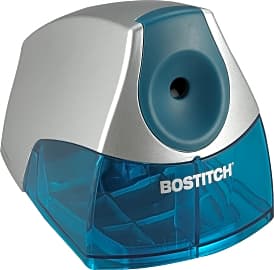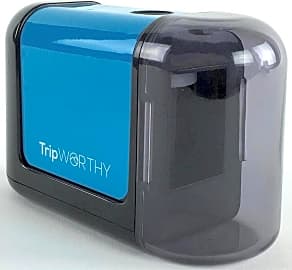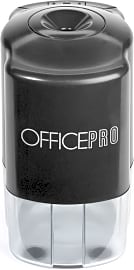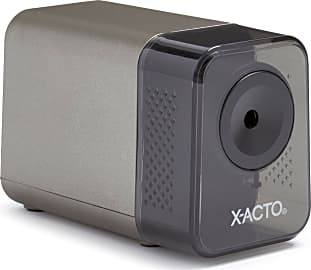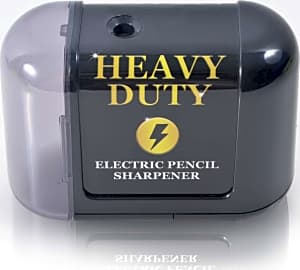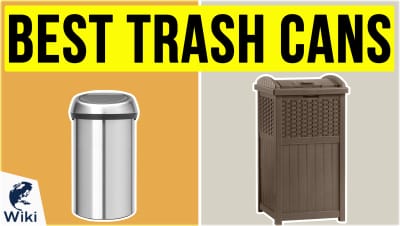The 10 Best Electric Pencil Sharpeners

This wiki has been updated 40 times since it was first published in April of 2015. As any student, artist, or architect knows, a broken pencil can interrupt your workflow and your train of thought. The electric sharpeners featured here can have you back up and running in no time, though, making them great for classroom and office use. Many offer quiet motors, spacious receptacles for collected shavings, and automatic shutoff capabilities for safety. When users buy our independently chosen editorial recommendations, we may earn commissions to help fund the Wiki.
Editor's Notes
October 27, 2020:
The Bostitch EPS4 joins the list in this update as a reliable choice that’s both compact and works quickly. A significant portion of its housing consists of the collection bin, so you won’t have to spend too much time on trips to the waste basket. It’s made with convenience in mind, with a power cord that can be detached for storage purposes. It boasts a sleek, modern look, and comes in your choice of black, gray, or two shades of blue. To make room for this new model, we say goodbye to the Linkyo Smart Sensor, due to availability concerns. The new addition joins another well-regarded model from the same manufacturer, the Bostitch QuietSharp 6. This vibrant blue model makes an attractive addition to any desktop, and also can be counted on to create a nice, symmetrical point. For safety’s sake, its motor won’t run when the shavings bin isn’t attached, which also help keep it from making a mess.
We felt the X-Acto School Pro deserved a prominent spot on the list, as it has a lot to offer, including a six-hole dial that makes it compatible with most sizes of school pencils. It’s got a quiet motor, so it won’t disrupt an entire classroom, and creates precise tips to minimize lead breakage, so students won’t need to keep coming back to the sharpener due to broken pencils. Its generous five-foot power cord gives you some flexibility on where to place it, and the transparent reservoir lets you know how full it is with just a quick glance. Two popular models from School Smart reside on the list. The School Smart Vertical is one of our top picks, thanks to its simple top-loading design that lets gravity do the work when you insert your pencil. It’s also got a sleek, modern design, works quickly and efficiently, and includes high-traction pads on the bottom to keep it in place securely. While it can be a bit noisy, the School Smart Electric is quite the workhorse that’s protected against overheating and compatible with both graphite and colored pencils.
November 05, 2019:
A sturdy, reliable electric sharpener can minimize your downtime or the disruption to your thoughts when you have to take care of a broken pencil. Our selection features many tried-and-true models that are great for use in schools or the office, with many in muted colors and sleek designs that will match just about any décor.
Some of the picks listed here even work with colored pencils, such as the TeachingMart Heavy-Duty, which makes it a popular choice among adult coloring book enthusiasts.
The Artist Choice Heavy Duty is a new addition to our list, and it’s great for those who want a portable choice that doesn’t require a cumbersome power cord. It runs on four AA batteries and weighs just nine ounces. You can buy it with confidence, thanks to its money-back guarantee. While it’s a highly affordable option, note that you’ll need to hold it down during use since it does not have any rubber feet on the bottom to keep it in place.
Leaving the list is the SmartPro Dual-hole, which is no longer currently available.
Special Honors
Hovel While it might not be electric, this reimagined device allows you to whittle your pencil to any desired point. It’s designed to last a lifetime, and boasts an elegant, solid machined brass body that can gain character as it ages. Its blades are made of carefully selected carbon steel. It’s specially designed not to break the lead, unlike many other models that twist and snap graphite. makerscabinet.com
Your Fingers To A Point
They could be bolted to a wall, a desktop, a counter–anything that could withstand the pressure of a young hand cranking away on the handle.
Elementary schools have long been outfitted with those iconic manual pencil sharpeners, the ancient-looking, metallic numbers with bodies shaped like flat-edged eggs. They could be bolted to a wall, a desktop, a counter–anything that could withstand the pressure of a young hand cranking away on the handle.
The dangerous thing about children's hands, and the reason I assume that most school systems still prefer manual sharpeners to electric ones, is that they have a few digits that are actually small enough to fit inside the sharpener.
When I was a kid, it was a common dare to stick your pinky–or whichever finger might fit–through the opening and turn the crank. Nobody really ever got hurt because the amount of finger sharpening going on was directly related to the pressure on the handle, and most kids yanked their fingers out the moment they felt the gears turning inside.
Most pencil sharpeners of this grade, be they manual or electric, consist of two corrugated barrels with moderately sharp ridges on them. Your pencil point ends up between these barrels, and their edges carve away at the pencil's wood and graphite in waves, producing a sharper and sharper point to your pencil the longer you spend in the moving machine.
Electric sharpeners have a simple sensor in them that detects the presence of the pencil either by touch or light sensitivity, depending on the brand and model. Pass a certain point with the pencil tip, and the sharpener engages.
Fancier models have adjustable sharpness settings, which are especially useful for artists who want to have a specific point to their pencils before putting them to paper. Some artists may even try to repeat the challenge presented to the grade school students mentioned above, and fill their creations in with a little all-natural red ink–I do not recommend this method.
Pencil Tip Of The Day
If you're a pencil person, you're well-acquainted with the terrible feeling in your body when the point of your pencil breaks. It starts in your fingertips and jumps aggressively up the arm, debilitating the shoulder and making a beeline for your heart. Having a sharp pencil in reserve is often the fastest remedy, but it's not always the case.
If you're a pencil person, you're well-acquainted with the terrible feeling in your body when the point of your pencil breaks.
Keeping a high-quality pencil sharpener in or around your work space is the only surefire way to keep this anxiety from slamming the breaks on your creative progress. Exactly which electric sharpener you choose to enter into your workflow depends a lot on what the ergonomics are of that space, and your specific use of the pencils in question.
If you're a multi-tasker, liable to find yourself writing or drawing with one hand while mixing coffee and filing papers with your other, you're going to want your electric pencil sharpener to have its hole located on top. Sure, some of the front-facing hole models have suction cups and other gimmicks to keep them in place if you try to push your pencil into them with just the one hand, but, more often than not, you end up pushing the sharpener itself across your desk without shredding a single layer of graphite.
With an upright sharpener, you can let gravity assist you as you press your pencil downward through the sharpener's blades until it's perfectly honed.
You may be a more patient worker, though, preferring to accomplish one task at a time, reveling in the specificity of your moments. For you, a lateral sharpener will do just fine, and will usually be produced by the higher-quality brands on the market, like industrial manufacturers such as Bostitch or fine art suppliers like X-Acto.
Whittling Down The Competition
There are gift shops and stationary stores in the world that will sell you novelty pencils of enormous size. They're particularly difficult to write with, but they are even more impossible to sharpen. You have to reach back to the earliest days of the pencil to find a suitable sharpening method: the knife. The first pencil sharpeners of any kind were knives and hands, used to whittle the edges of a pencil to a crude point, the graphite tip (lead long ago) sticking out just far enough to be of use.
The first electric pencil sharpeners were right around the corner, advertised by Farnham Printing and Stationary Company in 1917.
We have the French to thank for the development of the original pencil sharpeners, whose design from the early decades of the 1800s isn't far off from the single-blade, prism-style sharpeners kids still carry around in their pencil cases.
The mechanical pencil sharpeners with which we've become familiar in public schools around the world didn't come about until 1904, with a design strikingly similar to contemporary models, albeit less effective and more intricate in its manufacture.
The first electric pencil sharpeners were right around the corner, advertised by Farnham Printing and Stationary Company in 1917. Several other companies like Swingline and Polar Cub developed their own competitive versions through the 50s and 60s, with a boom in production arriving alongside the explosion of big-box office stores like Staples and Office Depot in the 1990s.




